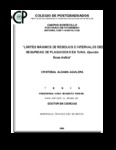| dc.description.abstract | Dado que no existen plaguicidas registrados para el manejo fitosanitario de las
plagas que afectan la producción de tuna, Opuntia ficus-indica (L) Miller 1768,
se propusieron límites máximos de residuos (LMRs) de siete plaguicidas en esta
fruta. En la evaluación del riesgo dietético crónico se estimaron los niveles de
exposición con los métodos de Ingesta Diaria Teórica Máxima (IDTM) e Ingesta
Diaria Estimada (IDE). En 2006, se realizaron dos aplicaciones de los
plaguicidas malatión, clorpirifos, permetrina, diazinón y dimetoato a la dosis
máxima recomendada en las etiquetas. A partir de la segunda aplicación, se
realizaron muestreos a los 0, 3, 7, 14, 21 y 28 días después de la aplicación
(DDA) y la determinación de sus residuos se hizo por cromatografía de gases y
espectrometría de masas. En 2007, se aplicaron spinosad y abamectina, se
muestreó a los 0, 1, 3, 7 y 14 DDA y sus residuos se analizaron por
cromatografía de líquidos y detector de arreglo de diodos. Las curvas de
disipación se definieron matemáticamente para establecer las relaciones
óptimas entre los residuos de plaguicidas y el tiempo. Los LMRs propuestos de
malatión, clorpirifos, permetrina, diazinón, dimetoato, spinosad y abamectina
en tuna son 8.0, 1.0, 3.0, 0.5, 2.0, 0.3 y 0.1 mg kg-1, respectivamente. Las
IDTMs o IDEs no excedieron las IDAs. Los parámetros de validación para los
análisis de residuos de plaguicidas estuvieron dentro de los valores de
referencia aceptables y los límites de cuantificación fueron menores a los LMRs
propuestos. Los intervalos de seguridad propuestos para los plaguicidas en
tuna son de 4, 17, 4, 10, 16, 5 y 2 días, respectivamente.__________Given that there are not registered pesticides available for phytosanitary
control of pest affecting the production of prickly pear cactus fruit, Opuntia
ficus-indica (L) Miller 1768, maximum residue limits (MRLs) of seven pesticides
were proposed in this fruit. In the chronic dietary risk assessment, the levels of
exposure were estimated through the theoretical maximum daily intakes
(TMDIs) and estimated daily intake (EDIs) methods. In 2006, the insecticides
malathion, chlorpirifos, permethrin, diazinon and dimethoate were applied two
times at maximum labeled doses. From the second application, the samplings
were carried out at 0, 3, 7, 14, 21 and 28 days after application (DAA) and the
residue determination were made by gas chromatography and mass
spectrometry. In 2007, the pesticides spinosad y abamectin were applied and
the samplings were made at 0, 1, 3, 7 and 14 DAA and the residues were
analyzed by liquid chromatography with diode array detector. Mathematically
defined decline curves were established by determining optimal relationship
between pesticide residues and time. The proposed MRLs of malathion,
chlorpirifos, permethrin, diazinon, dimethoate, spinosad and abamectin in
prickly pear cactus are 8.0, 1.0, 3.0, 0.5, 2.0, 0.3 and 0.1 mg kg-1, respectively
for each pesticide. The TMDIs or EDIs did not exceed their ADIs. The validation
parameters for pesticide residue analysis were between the acceptable
reference values and the quantitation limits were lower than the proposed
MRLs. The proposed safety intervals for the pesticides in prickly pear cactus
fruit are 4, 17, 4, 10, 16, 5 and 2 days, respectively. | es |

